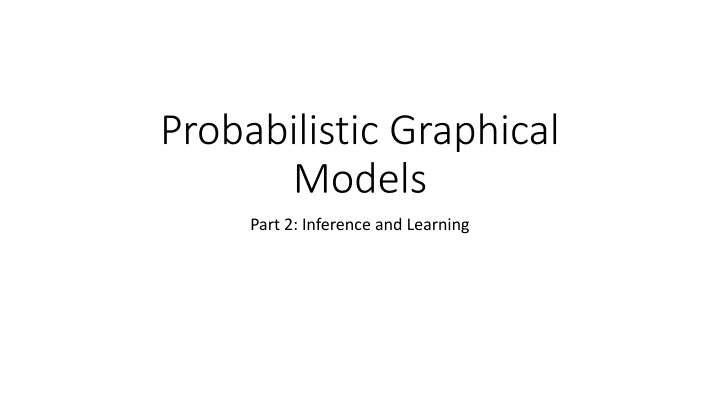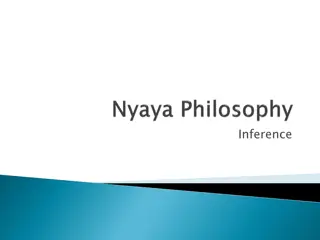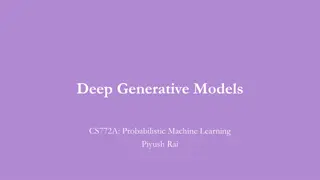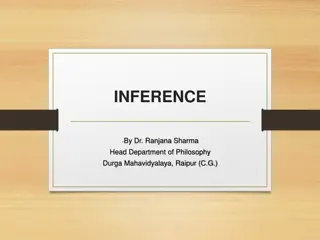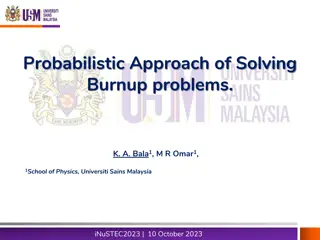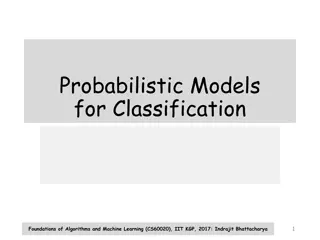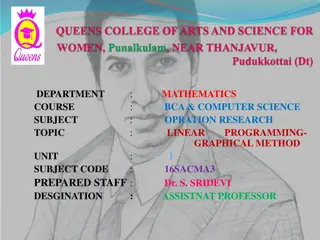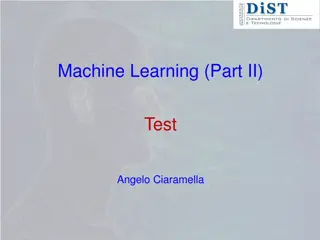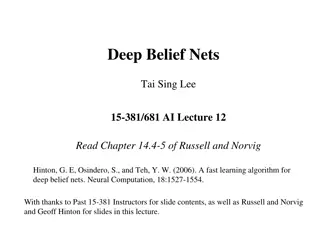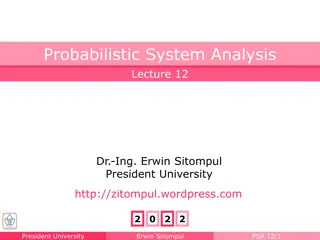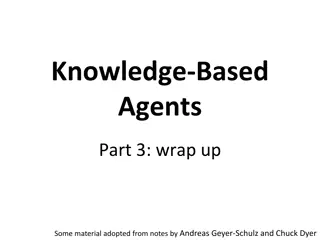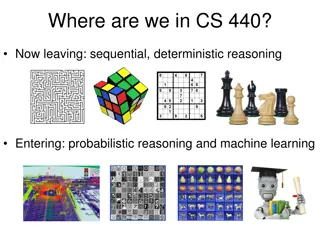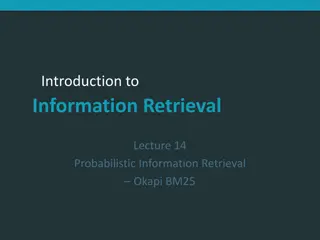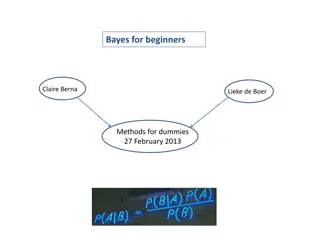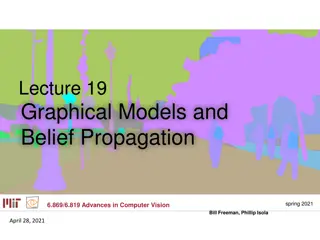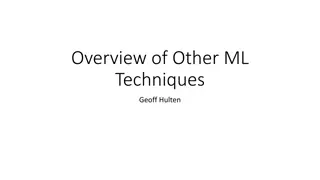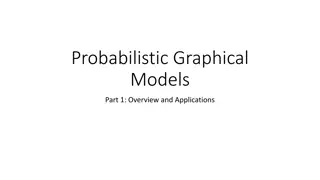Probabilistic Graphical Models Part 2: Inference and Learning
This segment delves into various types of inferences in probabilistic graphical models, including marginal inference, posterior inference, and maximum a posteriori inference. It also covers methods like variable elimination, belief propagation, and junction tree for exact inference, along with approximate methods such as loopy belief propagation and variational inference. An illustrative example of marginal inference using variable elimination in a chain Bayesian network is provided.
Download Presentation

Please find below an Image/Link to download the presentation.
The content on the website is provided AS IS for your information and personal use only. It may not be sold, licensed, or shared on other websites without obtaining consent from the author.If you encounter any issues during the download, it is possible that the publisher has removed the file from their server.
You are allowed to download the files provided on this website for personal or commercial use, subject to the condition that they are used lawfully. All files are the property of their respective owners.
The content on the website is provided AS IS for your information and personal use only. It may not be sold, licensed, or shared on other websites without obtaining consent from the author.
E N D
Presentation Transcript
Probabilistic Graphical Models Part 2: Inference and Learning
Outline Inference Marginal Inference Posterior Inference Maximum a posteriori inference Learning: Training Probabilistic Graphical Models Parameter Learning Structure Learning Hands-on DGM and UDM examples
Inference1 Given a probabilistic model, we are interested in using it to answer questions, e.g., determine the probability that a given email is spam: Marginal inference: what is the probability of a (set of) variable(s) after we marginalize everything else out (e.g., probability of spam vs. non-spam)? ? ? = 1 = ?(? = 1,?1,?2, ??) ?1 ?2 ?? Posterior inference: what is the posterior probability of a (set of) variable(s) given some evidence? ? ? = 1| ?1 = 1,?2 = 0 = ?(?,?1 = 1,?2 = 0,?3 ??) ?3 ?4 ?? Maximum a posteriori (MAP) inference: what is the most likely assignment of the variables in the model, possibly conditioned on evidence? max ?1,?2, ???(? = 1,?1,?2, ??)
Summary of Inference Methods1 Method Type of Inference Exact/Approximate Properties Variable Elimination Marginal/Posterior Exact Finds marginal of one variable Belief Propagation Marginal/Posterior Exact Finds marginal of all variables Works on tree structures Junction Tree Marginal/Posterior Exact Works on general graphs May become intractable Loopy Belief Propagation Marginal/Posterior Approximate Works on general graphs MIP based MAP Exact Works on general graphs Usually creates large MIP problems Max-product MAP Exact Works on tree structures Sampling based Marginal/Posterior/MAP Approximate Draws samples from the joint distribution Variational Inference Marginal/Posterior/MAP Approximate Replaces joint distribution with a simpler one
Marginal Inference Variable Ellimination1 X1 X2 X3 X4 Illustrative Example: Assume a chain Bayesian Network with probability distribution of the form: 4 ? ?1,?2,?3,?4= ? ?1 ?=2 ? ?? ?i 1) = ? ?1 ? ?2|?1 ? ?3|?2 ? ?4|?3 = ?1?1 ?2?2,?1 ?3?3,?2 ?4?4,?3 We are interested in computing the marginal probability P(X4).
Marginal Inference Variable Ellimination1 X1 X2 X3 X4 Illustrative Example: Assume a chain Bayesian Network with probability distribution of the form: 4 ? ?1,?2,?3,?4= ? ?1 ?=2 ? ?? ?i 1) = ? ?1 ? ?2|?1 ? ?3|?2 ? ?4|?3 = ?1?1 ?2?2,?1 ?3?3,?2 ?4?4,?3 We are interested in computing the marginal probability P(X4). Na ve Way: ? ?4= ?1?1 ?2?2,?1 ?3?3,?2 ?4?4,?3 ?3 ?2 ?1
Marginal Inference Variable Ellimination1 X1 X2 X3 X4 Illustrative Example: We may rewrite the sum in a way that pushes in certain variables deeper into the product: ? ?4= ?1?1 ?2?2,?1 ?3?3,?2 ?4?4,?3 ?3 ?2 ?1 = ?3 ?2?3(?3,?2) ?4(?4,?3) ?1?2(?2,?1) ?1(?1) = ?3?4(?4,?3) ?2(?3(?3,?2)* ?1?2(?2,?1)* ?1(?1))
Marginal Inference Variable Ellimination1 + can answer marginal inference queries for both directed and undirected networks - algorithm must be restarted from scratch for each variable
Marginal Inference Belief Propagation1 Variable Elimination as Message Passing: Assume we want to compute : ? ?3= ?1?1 ?2?2,?1 ?3?3,?2 ?4(?4,?3) ?1 ?2 ?4 X1 X2 X3 X4 moralized graph X1 X2 X3 X4
Marginal Inference Belief Propagation1 Variable Elimination as Message Passing: Root the tree at X3: X1 X3 X2 X2 X4 X3 X1 X4
Marginal Inference Belief Propagation1 Variable Elimination as Message Passing: Then post order traversal gives the sum: ?4?4(?4,?3) ?2(?3(?3,?2)* ?1?2(?2,?1)* ?1(?1)) X3 X2 X4 X1
Marginal Inference Belief Propagation1 Variable Elimination as Message Passing: The process can be regarded as message passing among nodes where: X3 m23(x3) m12X2= ?1?2?2,?1 ?1(?1) m23X3= ?2?3?3,?2 ?12(?2) m43X3= ?4?4?4,?3 p X3= m43X3 * m23X3 X1 m43(x3) X2 X4 m12(x2)
Marginal Inference Belief Propagation1 Variable Elimination as Message Passing: If we now want to compute p(x2): X2 m32(x2) m12X2= ?1?2?2,?1 ?1(?1) m43X3= ?4?4?4,?3 m32(X2) = ?3?3?3,?2 ?43(?3) p X2= m32X2 * m12X2 X4 m12(x2) X3 X1 m43(x3) It is using a lot of the same messages as before!
Marginal Inference Belief Propagation1 Belief propagation is computing all the messages at once for all marginal probabilities. In the context of marginal inference, it is also called sum-product message passing. It is defined as follows: While there is a node Xiready to transmit to Xj, send the message: ?????= ?? (??) (??,??) * ? ?(?)\j???(??) This message is precisely the factor that Xi would transmit to Xj during a round of variable elimination. After having computed all the messages: ? ?? (??) * ? ?(?)???(??)
Marginal Inference Belief Propagation1 Factor Graphs describe this computation more explicitly (sum-product algorithm):
Marginal Inference Belief Propagation1 Junction Tree Algorithm works on general graphs partitions the graph into clusters of variables the variables within a cluster can be highly coupled interactions among clusters must have a tree structure at each step, each cluster marginalizes out the variables that are not in the scope of its neighbor message passing is performed among clusters
Marginal Inference Belief Propagation1 Loopy belief propagation: An approximate algorithm that discards cycles in the graph and performs message passing anyways. Messages are initialized uniformly. It continues until convergence (i.e., when messages do not change). Works surprisingly well in practice.
MAP Inference1 MAP inference in a graphical model P corresponds to the following optimization problem: ??????????? ? = ???? ? ?(??) ????, where ???= log ?(??) The constant does not depend on X and can be ignored: ??????????? ? = ???? ?(??) ?
MAP Inference1 Formulating MAP Inference as Mixed Integer Programming (MIP). Assume a pairwise MRF: 1. Introduce two indicator variables A variable i(Xi) for each i V and state Xi A variable ij(Xi, Xj) for each edge (i, j) E and pair of states Xi, Xj 2. Rewrite MAP objective using those variables
MAP Inference1 Formulating MAP Inference as Mixed Integer Programming (MIP). Assume a pairwise MRF: 3. Subject on the value constraints
MAP Inference1 Formulating MAP Inference as Mixed Integer Programming (MIP). Assume a pairwise MRF: 4. And the consistency constraints Can be solved with off the self MIP solvers, such as Gurobi and CPLEX
MAP Inference Message Passing1 By replacing sums in marginal inference with maxes, we can solve the MAP inference problem (max-product algorithm) Typically, slower than the MIP approach However, can be very easily built into systems that implement message passing There exists a very effective approximate variation
Approximate Inference1 Sampling: generate samples from the multidimensional probability distribution described by the graphical model: Forward Sampling Markov Chain Monte Carlo: Metropolis Hasting, Gibbs Sampling Rejection Sampling Importance Sampling + Guaranteed to find a globally optimal solution given enough time - Difficult to tell how close to the optimal solution they are within a finite amount of time - Generally slow to converge
Approximate Inference1 Variational Inference: Given an intractable distribution P find a simpler distribution Q, that is as similar to P as possible: Choose a class of tractable distributions Q Solve an optimization problem to choose q Q which is most similar to P Kullback-Leibler divergence to quantity similarity among probability distributions - Will almost never find a globally optimal solution + May produce bounds on their accuracy + Scales better + Can leverage state of the art computation techniques Stochastic gradient optimization Acceleration using GPUs Parallelization
Learning1 Given a dataset, we would like to fit (train) a model that will make useful predictions on various tasks that we care about: Parameter learning: the graph structure is known, and we want to estimate the factors/parameters/potential functions. Structure learning: we want to estimate the graph, i.e., determine from data how the variables depend on each other
Learning Directed Graphical Models1 Maximum Likelihood Construct the likelihood L(D| ) i.e., the probability of seeing the data, given the parameters (unknowns) for the give dataset D Fill in the data values and identify the parameters the maximize L by computing: ??? log ? ? = ??? log?(?| ) ? ?
Learning Undirected Graphical Models1 Analytically solving maximum likelihood is usually expensive because of the normalization constant Approximate methods: Gradient descend employ sampling to approximate gradient contrastive divergence to decrease the required sampling steps Pseudo-likelihood: compute likelihood of a subset of variables, assuming the values of the rest of the variables are fixed
Learning Latent Variable Models1 Expectation Maximization Relies on two simple assumptions: If the latent variable Z were fully observed, then we could optimize the log- likelihood exactly as previously Knowing the weights, we can often efficiently compute the posterior P(Z X; )
Learning Latent Variable Models1 Expectation Maximization Given a dataset D: Starting at an initial 0, repeat until convergence for t = 1, 2, : 1. E-Step: For each X D, compute the posterior p(Z | X; t) 2. M-Step: compute new weights via:
Learning1 Structure Learning for Bayesian Networks score-based approach defines a criterion to evaluate how well the Bayesian network fits the data penalized log likelihood searches over the space of DAGs for a structure with maximal score local search greedy search constraint-based search employs the independence test to identify a set of edge constraints for the graph finds the best DAG that satisfies the constraints order-search: searches only over the graphs that obey a chosen topological order MIP-based: encodes graph structure, scoring and acyclic constraints into an MIP problem
References 1. https://cs.stanford.edu/~ermon/cs228/index.html 2. http://ftp.mi.fu-berlin.de/pub/bkeller/MatLab/Examples/bayes/lungbayesdemo.html 3. A. Radford, L. Metz and S. Chintala: Unsupervised Representation Learning with Deep Convolutional Generative Adversarial Networks, ICLR 2016 4. D. Aronsky and P. J. Haug: Diagnosing community-acquired pneumonia with a Bayesian network, Proc. AMIA Symposium 1998 5. Y. Ni, P. M ller, L. Wei and Y. Ji: Bayesian graphical models for computational network biology, BMC Bioinformatics 63(2018) 6. J. A. Bilmes: Graphical Models and Automatic Speech Recognition, The Journal of the Acoustical Society of America, 2011 7. W.-N. Hsu, Y. Zhang, R. J. Weiss, H. Zen, Y. Wu, Y. Wang, Y. Cao, Y. Jia, Z. Chen, J. Shen, P. Nguyen and R Pang: Hierarchical Generative Modeling for Controllable Speech Synthesis, ICLR 2019 8. W. Ping and A.T. Ihler: Belief Propagation in conditional RBMS for structured prediction, AISTATS 2017 9. https://www.mpi-inf.mpg.de/fileadmin/inf/d2/GM/2016/gm-2016-1213-imageprocessing.pdf 10. D. P. Kingma and M. Welling : An Introduction to Variational Autoencoders, Foundations and Trends in Machine Learning: Vol. 12 (2019)
